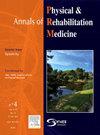脊髓灰质炎晚期影响及相关因素患者10年内自我报告损伤的变化:一项纵向队列研究
IF 4.6
3区 医学
Q1 REHABILITATION
Annals of Physical and Rehabilitation Medicine
Pub Date : 2025-04-18
DOI:10.1016/j.rehab.2025.101969
引用次数: 0
摘要
背景:许多患有脊髓灰质炎晚期影响的老年人会出现新的或加重的损伤,这可能对日常生活产生负面影响。目前,关于leop相关损伤如何随时间变化的知识有限。目的评价LEoP患者自我报告的各种损伤在10年内的变化,并探讨其变化的相关因素。方法:本研究是一项纵向队列研究,共有181名LEoP患者(平均年龄77岁[SD 9],其中99名女性)接受了两次邮寄调查,间隔10年。该调查包括人口统计学、临床特征和自我报告的损伤(用脊髓灰质炎晚期影响者自我报告损伤量表评估)等问题。SIPP包括13个项目,询问参与者在过去两周内受到各种与leap相关的障碍的困扰程度。采用配对样本t检验分析SIPP评分的变化。采用单变量线性回归分析影响SIPP总分变化的相关因素。结果SIPP的7个项目在10年内显著增加(P <;0.05):肌肉无力、肌肉疲劳、感觉障碍、休息和运动时呼吸困难、不耐寒和全身疲劳(对应1-12%)。SIPP总分平均上升1.64分(CI, 0.88 ~ 2.41, P <;0.001),对应于6%。两个变量与SIPP总分的变化显著相关:自我报告的leap相关残疾程度(B = 2.96, 95% CI, 0.88-5.03;P = 0.006)和合并症的存在(B = 1.72, 95% CI, 0.14-3.30;P = 0.033)。结论LEoP术后损伤在10年内呈增加趋势,但幅度较小。中度至重度leo相关残疾和合并症与损伤增加有关。这些发现可用于后续随访以及为LEoP患者提供和制定以人为本的干预措施。本文章由计算机程序翻译,如有差异,请以英文原文为准。
Changes in self-reported impairments over 10 years in people with late effects of polio and associated factors: A longitudinal cohort study
Background
Many people ageing with late effects of polio (LEoP) experience new or increased impairments which could negatively influence daily life. Currently, there is limited knowledge how LEoP-related impairments change over time.
Objectives
To assess how various self-reported impairments change over 10 years among people with LEoP, and explore factors associated with the changes.
Methods
This is a longitudinal cohort study, in which 181 people with LEoP (mean age 77 [SD 9] years, 99 women) responded to a postal survey twice, 10 years apart. The survey included questions on demographics, clinical characteristics, and self-reported impairments as assessed with the Self-reported Impairments in Persons with late effects of Polio (SIPP) scale. The SIPP comprises 13 items and asks how much participants have been bothered by various LEoP-related impairments during the past 2 weeks. Changes in SIPP scores were analyzed by paired sample t-test. Factors associated with the changes in SIPP total scores were analyzed with univariable linear regression analyses.
Results
Seven items in the SIPP increased significantly over the 10 years (P < 0.05): muscle weakness, muscle fatigue, sensory disturbances, breathing difficulties at rest and during physical activity, cold intolerance, and general fatigue (corresponding to 1–12%). The SIPP total score increased on average 1.64 points (CI, 0.88 - 2.41, P < 0.001), corresponding to 6%. Two variables were significantly associated with the change in SIPP total score: self-reported degree of LEoP-related disability (B = 2.96, 95% CI, 0.88–5.03; P = 0.006) and presence of co-morbidities (B = 1.72, 95% CI, 0.14–3.30; P = 0.033).
Conclusions
Impairments following LEoP seem to increase over a 10-year period but to a small degree. Having moderate to severe LEoP-related disability and comorbidities are associated with increased impairments. These findings can be accommodated in follow-ups and when providing and developing person-centered interventions for people with LEoP.
求助全文
通过发布文献求助,成功后即可免费获取论文全文。
去求助
来源期刊

Annals of Physical and Rehabilitation Medicine
Medicine-Rehabilitation
CiteScore
7.80
自引率
4.30%
发文量
136
审稿时长
34 days
期刊介绍:
Annals of Physical and Rehabilitation Medicine covers all areas of Rehabilitation and Physical Medicine; such as: methods of evaluation of motor, sensory, cognitive and visceral impairments; acute and chronic musculoskeletal disorders and pain; disabilities in adult and children ; processes of rehabilitation in orthopaedic, rhumatological, neurological, cardiovascular, pulmonary and urological diseases.
 求助内容:
求助内容: 应助结果提醒方式:
应助结果提醒方式:


